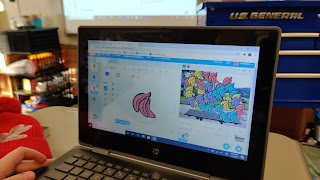What a year it has been thus far in the STEM Lab. Despite my best intentions to keep up with this blog, the fast pace brought on by 1 week rotations (rather than 2 week), and the challenges of teaching both in person and virtual students simultaneously, defeated me.
We have been busy as usual in the lab (which is to say on a cart that I have been pushing around the school since October). Here's the short version of what has been going on with the STEM Lab.
Computer programming
As always, developing computer programming skills is an important element of our practice. Coding helps build critical problem solving and algorithmic thinking strategies. My approach in the lab places equal emphasis on instilling a sense of creative confidence in the students. I want them to thinking of programming not as an activity, but as a tool they can employ to share their learning and express their ideas.Kindergarten, first, and second grades have been using Code.org and Scrach Jr while the third through fifth graders have been using Scratch.
Math Stories and Math Art Challenges
Kindergarten and first grade recently finished up an unit on math stories. Each day we read a book that combined literature and a math concept. Following the book students completed a an activity related to the book's theme.
Earlier in the year, all of the students in Kindergarten through fifth grade enjoyed a unit of math art challenges. This unit was a playful exploration of the connections between mathematics and art. We looked at elements of geometry and probability along with patterns. Most of the math art challenges were adapted from a project maintained by Annie Perkins on her website: #MathArtChallenge. Many of these are geared towards middle and high school math students, but there are several that work for elementary students.Skype-a-Scientist and Research Projects
One of my favorite additions to the STEM lab over the last couple of years is Skype-a-Scientist. This organization matches K-12 educators with scientists working in a variety of fields. This gives students the opportunity to have a conversation with (as many say) "a real live scientist". They learn about the diversity of careers paths in the sciences and see that science is open to people of all backgrounds. Over the years we have spoken with ecologists, biologists, paleontologists, speleologists, and more. We have met people from the USA, UK, Sweden, Germany, Portugal, and Brazil.
I incorporate Skype-a-Scientist meetings as part of projects that have students researching and sharing their learning. This year so far all of second (learning about food webs) and third grade (coral reef ecology) have had scientist meetings. By the time spring break gets hear, fifth grade (cartography) will be part of that list as well. Going forward, fourth and first will have their turns.Building
One activity that has fallen by the wayside during the pandemic is physical building and making. The projects cannot involve materials that are not common household items and for the in person students, they have to be simple enough that students can complete them independently. Then there was the issue of being on a cart and necessity that the materials be easy to move between classes.
Second grade is currently completing a project in which they are building 3D models of animals by combining 2D slotted cardboard pieces. The last day of the project has them mix up their pieces to create fantasy animals that they name and describe for science.
This has certainly been the strangest of school years. I am excited nonetheless about the projects I have planned for the rest of the year. Check back soon to see what we work on next.




















No comments:
Post a Comment